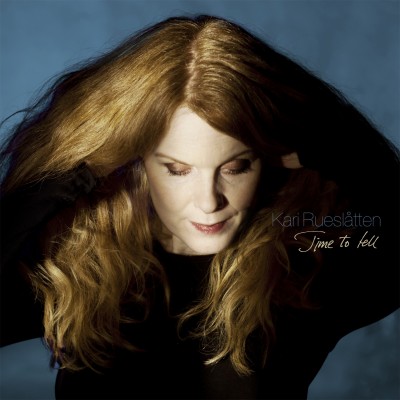Kari Rueslåtten, the quintessential Norwegian folk artist, released a brand new album after an eight year hiatus.
“What really triggered me to start making music again were all the kind messages I got from fans around the world asking me when new music would surface” said Rueslåtten.
“I am most humble and grateful to find that there are people out there who have followed my music since my early beginning, back in The 3rd and the Mortal days, and through all my solo-albums.”
Rueslåtten marks her 20th year as a musician with the release of “Time to Tell,” her fifth solo album and most recent offering in nearly eight years. Released by Despotz Records on March 7, the album features 11 songs, each of which are short, sweet, and mellow. Rueslåtten’s voice, tempered by years of classical training and practice of Norwegian folk music, is accompanied by piano and an arrangement of acoustic instruments, including pump organ and tremolo guitars.
“The composing has been done by me sitting at the piano singing,” writes Rueslåtten from her website, “No drum-beats or co-composers this time! I wanted to go back to the core of songwriting. If the verse and chorus works just accompanied by the piano – it will work with other arrangements in studio too.”
To promote the album, three singles were pulled from it. The first, “Why So Lonely,” is a re-recording of one of Rueslåtten’s earliest works and features Tuomas Holopainen from Nightwish on piano and keyboard. It is a far cry from the original, which was a haunting piece, but the 2014 version shows Rueslåtten has lost none of her vocal prowess and affinity for reinventing her sound.
Rueslåtten reflected upon the song, “I decided to look back in time and make a cover version of one of my favorite songs from the early years. In a way, it can be seen as a tribute to those who have showed interest in my music through so many years.”
The second single “Wintersong,” showcases Rueslåtten’s natural songwriting talents. Despite its minimalist envelope, the melodies are pleasant. The latest promotional single to be released is “Rainy Days Ahead.” This song exhibits an auspicious opportunity for Rueslåtten to take a stab at a commercial sound but not lose her soul.
“Time to Tell” is a quiet and non-imposing re-entry into the music industry for Rueslåtten. Nevertheless, she should take some humble pride in her milestone achievement. It is not some grand declaration for her to tout or plug as if it were a consumer item like some random Billboard Hot 100 track. It is more of a personal invitation to you, the listener, to peek into her world as she tells you a story. The album fits well into just about anyone’s personal catalog, whether you enjoy singer-songwriters or pop music with folk influence, or are a nostalgic metalhead wondering what one of their favourite female vocalist had been up to for so long.
Rueslåtten began her musical career in 1994 as a founding member of The 3rd and the Mortal, an experimental metal band incorporating an atmospheric avant-garde wall of sound. Their music was dark and gloomy, progressing through tubes like sludge under pressure, but Rueslåtten’s vocals are a stark contrast to the heavily rhythmic slough the band churned out. Her voice is soothing and soars over the slow beat of drums and the all-consuming scream of distorted guitars.
Hailing from Trondheim, Norway, the group was highly influential in Scandinavia’s underground metal scene, but also influenced mainstream and popular music throughout Europe. Such bands as Agalloch, The Gathering and Nightwish have cited The 3rd and the Mortal as an inspiration. The band released their first LP, “Tears Laid in Earth” in 1995 which became somewhat of a cult classic for doom metal enthusiasts.
Rueslåtten did not remain with The 3rd and the Mortal for long, however. Shortly after the release of “Tears Laid in Earth,” she left the band to focus on other projects. The first of these was a collaboration with black metal musicians Glyve Nagell and Sigurd Wongraven, better known as Fenriz and Satyr, respectively of Darkthrone and Satyricon fame. The project, called Storm, released one album in 1995 titled, “Nordavind,” featuring metalised renditions of traditional Norwegian folk songs.
Two years later, Rueslåtten released her first solo album, “Spindelsinn,” also featuring Norwegian aesthetics, but eschewing metal in favour of a folk-pop crossover. Lyrics, sung in Norwegian, had themes of dark forests, moonlight, trolls and witches. Using keys and synth as main instruments, it was quite a departure from her early days, but the change would allow her to find her own sound.
Rueslåtten adopted this style for subsequent albums to come. Her 1998 album, “Mesmerized,” also began a trend of writing songs in English. Her third album, “Pilot,” released in 2002, progressed even further into art pop territory, drawing comparisons to the likes of Tori Amos and Kate Bush. In 2004, her album “Other People’s Stories” is what solidified her sound and established her new identity, far and away from her work in the 90s. To date, it was her most mature and accomplished album. That is, until “Time to Tell” was released.
Note: This article was featured in The Prospector Summer 2014 edition.
All photos by Arlid Juul.
I come from a long line of yokels, mostly fishermen and truckers. Some then, find it odd that I am an aspiring economist and sociologist. The way I see it: my family’s tales of the road and the river humbled me, yet caused a thirst for adventure . I also like to write feature stories about interesting places and the beautiful people that live there. Like Yuba-Sutter.





Comment Policy: Comments are welcomed and encouraged. However, the editorial board reserves the right to edit or delete, without notice, any comments submitted to the blog. For more details, see our full Comment Policy.